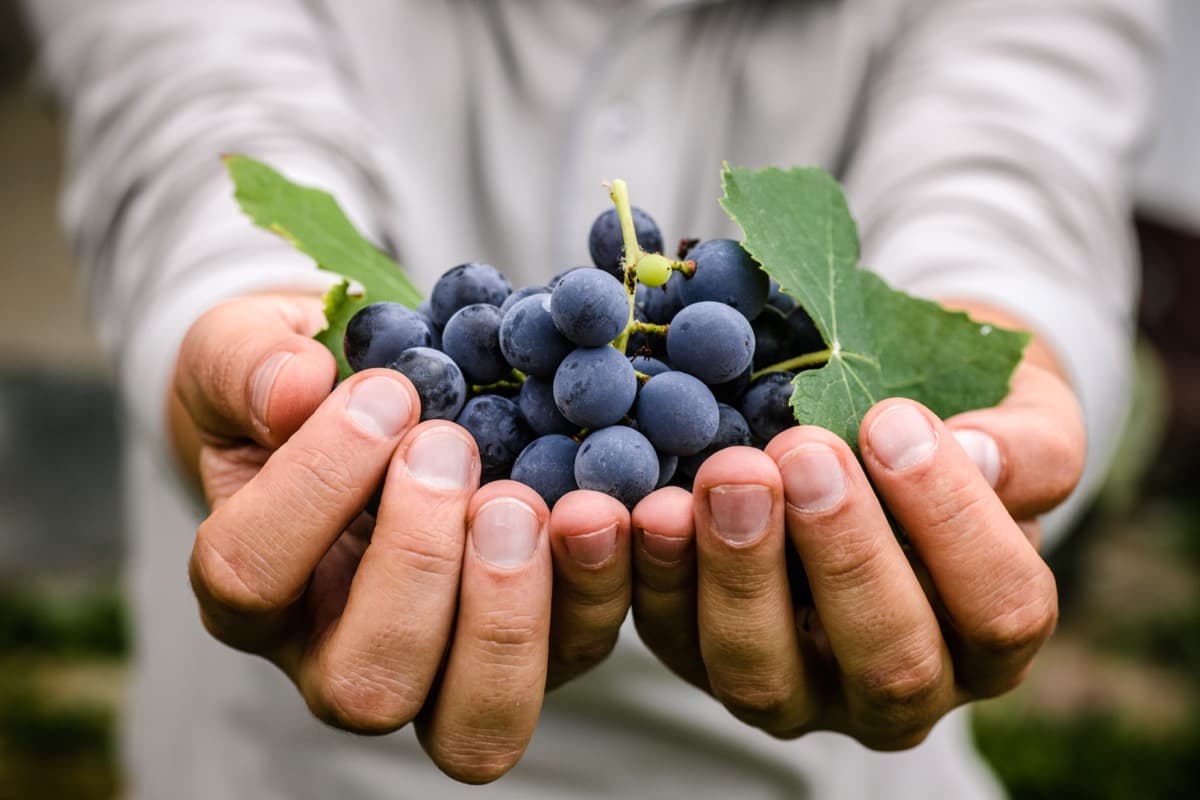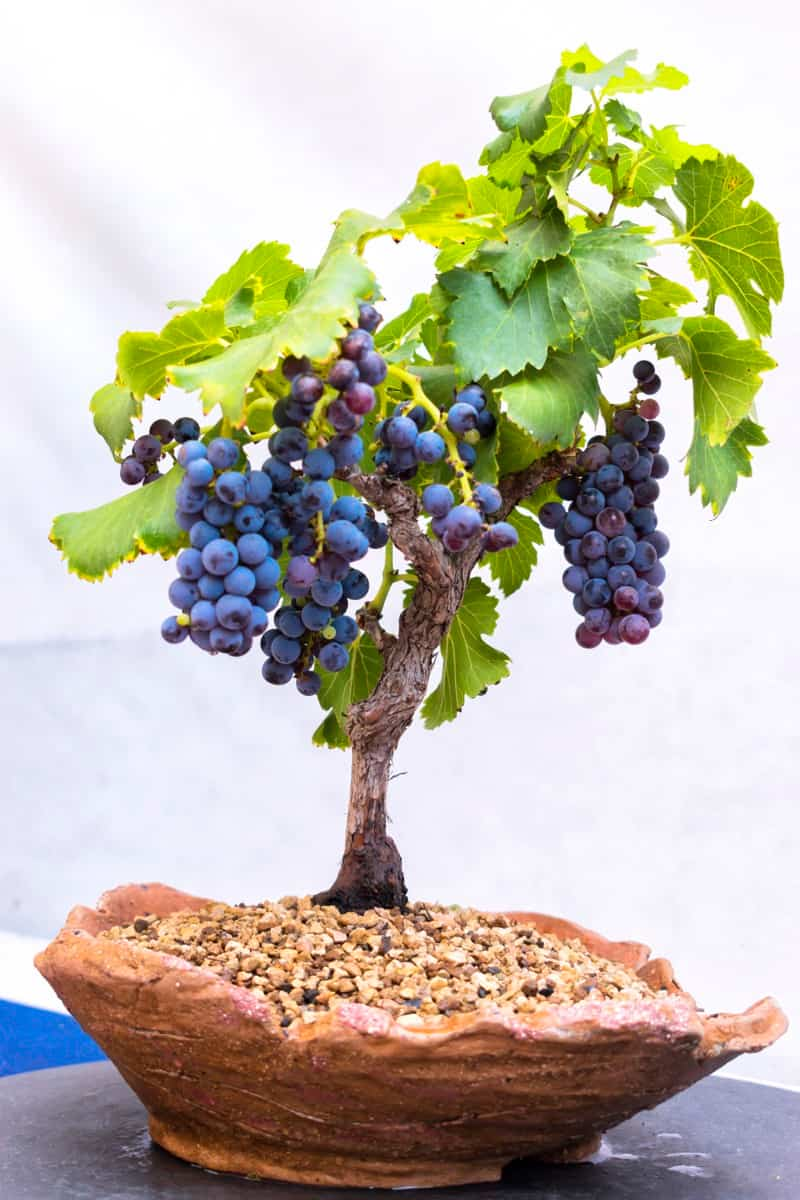Bonsai cultivation takes the majestic beauty of nature and scales it down into a miniature, living artwork that fits right into your home. Grape plants are an intriguing option for bonsai enthusiasts. Grape bonsai combines the vine’s exotic beauty, the fruit’s ornamental value, and the bonsai’s intricate and patient art.

This comprehensive guide is your go-to resource for understanding the process of planting, growing, and caring for bonsai grape plants. It covers various aspects, including seed germination, container choice, soil and sunlight requirements, grape bonsai pruning, watering and fertilizing, pest and disease protection, training techniques, and finally, the best methods for overwintering.
How to Grow and Care for Bonsai Grapes
How to Grow Bonsai Grapes From Seeds
Starting your grape bonsai journey from seeds can be a rewarding experience. The first step is acquiring the grape seeds. After obtaining the seeds, you will need to stratify them, which mimics natural winter conditions to stimulate germination. Typically, seeds are placed in a moist paper towel, sealed in a bag, and refrigerated for around six weeks.
After this cold period, you can sow the stratified seeds in a shallow tray filled with a good quality seed-starting mix. The seed tray should be kept in a warm, brightly lit spot, and the soil must be moist but not soggy. Germination can take anywhere from two to eight weeks. When the seedlings grow to a suitable size, they can be delicately moved to separate pots.
Choosing the Right Container for Bonsai Grape Plants
Choosing the correct container for your grape bonsai is crucial in ensuring its healthy growth and development. Unlike typical houseplants, bonsai trees require specific pots that cater to their unique needs. The choice of the pot will depend on the grape bonsai strain, size, and style.
The container should be large enough to accommodate the root system and have proper drainage holes to prevent waterlogging. As a rule of thumb, choose a pot roughly two-thirds the height of your bonsai for a visually balanced look. Material-wise, depending on your preference, you can opt for traditional ceramic pots or modern plastic ones.
Soil Requirements for Bonsai Grape
The soil is fundamental to any plant’s life, and bonsai grapes are no different. The best soil for bonsai grapes provides good drainage, adequate aeration, and a balance of essential nutrients. A common mix used by bonsai enthusiasts is a combination of akadama, pumice, and organic compost.
Akadama is a clay granule with excellent water-holding capacity, while pumice improves drainage and aeration. Organic compost provides the necessary nutrients for the plant’s growth. However, these are just guidelines, and the best soil mix can vary based on local climate and the specific needs of your grape bonsai.
Sunlight Requirements for Bonsai Grape Cultivation
Sunlight plays a vital role in photosynthesis, hence, bonsai grapes’ growth and development. Plants thrive with six hours of daily sunlight. However, in extremely hot climates, protect them from the harsh afternoon sun as it can scorch the leaves and hinder growth. Similarly, in indoor environments, they should be placed in a sunny location that receives plenty of natural light. If natural sunlight is insufficient, grow lights can provide supplemental lighting.
Pruning Techniques for Bonsai Grape Vines
Grape bonsai pruning goes beyond mere aesthetics; it aids the plant’s health and productivity. Pruning helps control the grape bonsai’s size and encourages it to produce more fruit. The best time to prune is during late winter when the plant is dormant before the new growth starts.
This is usually done using a sharp, clean pair of pruning shears. The main vine should be pruned back to 3-4 buds. Similarly, side branches should also be pruned to 1-2 buds. Pruning also plays a crucial role in shaping the bonsai and should be done in a way that follows the natural growth habit of the grapevine.
Watering Requirements for Bonsai Grape Plants
Watering is another key aspect of bonsai grape care. As a general rule, bonsai grapes prefer soil that is consistently moist but not waterlogged. Watering frequency varies based on factors like pot size, soil type, climate, and season. You may need to water your bonsai grape daily in hot and dry conditions. During winter, however, watering can be reduced. Always check the top inch of the soil for dryness before watering. Overwatering or underwatering can both lead to health problems for your grape bonsai.
In case you missed it: How to Plant, Grow, and Care for Apple Bonsai

Fertilizing Techniques for Bonsai Grape Trees
Fertilizing is an important step in maintaining the health and vitality of your grape bonsai. It provides the plant with nutrients that may not be in sufficient amounts in the soil. A balanced, slow-release fertilizer containing nitrogen, phosphorus, and potassium should be applied in early spring and late summer. Always follow the package instructions for the correct dosage and application. Avoid fertilizing during the dormant period in winter, as the plant’s nutrient needs are low.
Protecting Bonsai Grape Plants From Pests and Diseases
Like any plant, bonsai grapes can be affected by various pests and diseases. Common pests include aphids, mites, and scale insects, which can cause damage by sucking the plant’s sap. Diseases like powdery mildew and grape leaf spot can also affect bonsai grapes.
Prevention is always better than cure, and good cultural practices such as proper watering, adequate sunlight, and correct fertilization can go a long way in keeping your plant healthy. If infestations occur, use mild, organic pest control methods whenever possible. In the case of diseases, remove affected parts immediately to prevent their spread.
Training Techniques for Shaping Bonsai Grape Vines
The art of bonsai includes training the plant into a desired shape and form. For grape bonsai, the common styles include informal upright, slanting, cascade, and windswept. Wire training is a popular technique used to guide plant growth. In this method, wire is wrapped around the branches and gently bent to achieve the desired shape. Monitoring the plant closely during this process is essential, as the wire can cut into the growing bark if left on for too long. Other shaping techniques include pruning, pinching, and defoliation.
Overwintering Techniques for Bonsai Grape Plants
When the cold months approach, special care must be taken to ensure your bonsai grape plant survives the winter. Grape vines are hardy, but the miniature nature of bonsai makes them more susceptible to harsh weather conditions. Overwintering techniques depend on your local climate.
The bonsai grape plant can remain outdoors without protection if you live in a region with mild winters. However, it’s best to bring the plant indoors or into a greenhouse in regions with harsh winters. An important overwintering aspect is reducing watering but not letting the soil completely dry out. Additionally, remember that the plant is dormant during this period and does not require fertilization.
In case you missed it: How to Plant, Grow, and Care for Orange Bonsai

Conclusion
Growing, cultivating, and caring for bonsai grapes is a task of both patience and dedication. By understanding the fundamentals and intricacies of this process, you can ensure a rewarding and successful journey into bonsai cultivation.
- Feed Your Flock for Less: Top 10 Tips to Save on Chicken Feed
- Ultimate Guide to Ossabaw Island Hog: Breeding, Raising, Diet, and Care
- Hatching Answers: The Top 10 Reasons Your Chickens Aren’t Laying Eggs
- Eggs and Economics: Breaking Down the Cost of Raising Backyard Chickens
- Defend Your Greens: Proven Methods to Keep Iguanas Out of Your Garden
- Ultimate Guide to Cinnamon Queen Chicken: A Comprehensive Guide for Beginners
- Ultimate Guide to California Tan Chicken: Breeding, Raising, Diet, Egg-Production and Care
- Ultimate Guide to Marsh Daisy Chicken: Breeding, Raising, Diet, and Care
- 10 Types of Chicken Farming Businesses You Can Start for Profits